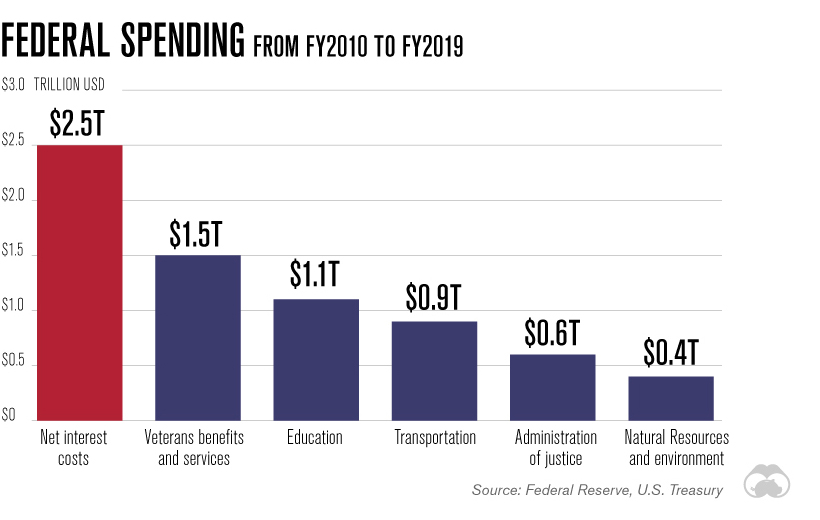[ad_1]
Public sector debt has been a contentious subject for a few years. Whereas some consider that extreme authorities borrowing might be dangerous over the long run, others have argued that it acts as a robust instrument for exciting development.
Within the U.S., the latter view seems to have taken maintain. Since 2008, America’s nationwide debt has surged almost 200%, reaching $27 trillion as of October 2020. To realize a greater understanding of this ever-growing debt, this infographic takes a better take a look at varied U.S. budgetary datasets together with the 2019 fiscal stability.
America’s Debt vs. GDP
Authorities money owed are sometimes represented by extremely massive numbers, making them laborious to understand. By evaluating America’s debt to its annual GDP, we will get a greater grasp on the relative measurement of the nation’s monetary obligations.
| 12 months | Complete Public Debt (USD) | GDP (USD) | Debt as % of GDP |
|---|---|---|---|
| 1994 | $4.5T | $7.1T | 63% |
| 1995 | $4.8T | $7.5T | 64% |
| 1996 | $5.0T | $7.9T | 63% |
| 1997 | $5.3T | $8.4T | 63% |
| 1998 | $5.5T | $8.9T | 62% |
| 1999 | $5.6T | $9.4T | 60% |
| 2000 | $5.8T | $10.0T | 58% |
| 2001 | $5.7T | $10.5T | 54% |
| 2002 | $5.9T | $10.8T | 55% |
| 2003 | $6.4T | $11.2T | 57% |
| 2004 | $7.0T | $11.9T | 59% |
| 2005 | $7.6T | $12.8T | 59% |
| 2006 | $8.2T | $13.6T | 60% |
| 2007 | $8.7T | $14.2T | 61% |
| 2008 | $9.2T | $14.7T | 63% |
| 2009 | $10.6T | $14.4T | 74% |
| 2010 | $12.3T | $14.7T | 84% |
| 2011 | $14.0T | $15.3T | 92% |
| 2012 | $15.2T | $16.0T | 95% |
| 2013 | $16.4T | $16.6T | 99% |
| 2014 | $17.3T | $17.1T | 101% |
| 2015 | $18.1T | $18.0T | 101% |
| 2016 | $18.9T | $18.5T | 102% |
| 2017 | $19.9T | $19.2T | 104% |
| 2018 | $20.5T | $20.2T | 101% |
| 2019 | $21.9T | $21.1T | 104% |
| 2020 | $23.2T | $21.6T | 107% |
| April 2020 | $23.7T | $19.5T | 122% |
Supply: Federal Reserve, U.S. Treasury
On this context, U.S. debt was comparatively average between 1994 to 2007, averaging 60% of GDP over the timeframe. This took a drastic flip in the course of the World Monetary Disaster, with debt climbing to 95% of GDP by 2012.
Since then, America’s debt has solely elevated in relative measurement. In April 2020, with the COVID-19 pandemic in full power, it reached a report 122% of GDP. This will sound troubling at first, however there are a couple of caveats.
For starters, there are numerous different advanced economies which have additionally surpassed the 100% debt-to-GDP milestone. Essentially the most noteworthy is Japan, the place the debt-to-GDP ratio has climbed past 200%. Moreover, this isn’t the primary time America has discovered itself on this state of affairs—by the tip of World Warfare II, debt-to-GDP peaked at 106% earlier than declining to historic lows within the Nineteen Seventies.
What’s Stopping the Debt From Shrinking?
Though the U.S. constantly pays off parts of its debt, the overall quantity it owes has elevated annually since 2001. That’s as a result of the federal authorities runs constant finances deficits, that means it spends greater than it earns. Throughout financial crises, these deficits can develop into extremely massive.
| Fiscal 12 months (Sept 30) | Funds Surplus or Deficit (USD billions) |
|---|---|
| 2000 | +$236B |
| 2001 | +$128B |
| 2002 | -$158B |
| 2003 | -$378B |
| 2004 | -$418B |
| 2005 | -$318B |
| 2006 | -$248B |
| 2007 | -$161B |
| 2008 | -$458B |
| 2009 | -$1,412B |
| 2010 | -$1,294B |
| 2011 | -$1,299B |
| 2012 | -$1,076B |
| 2013 | -$680B |
| 2014 | -$485B |
| 2015 | -$441B |
| 2016 | -$585B |
| 2017 | -$665B |
| 2018 | -$779B |
| 2019 | -$984B |
| 2020 | -$3,131B |
Supply: Federal Reserve
Within the aftermath of the World Monetary Disaster, the U.S. recorded an annual deficit of $1.4 trillion in FY2009. This was largely because of the $787 billion American Recovery and Reinvestment Act of 2009, which offered tax rebates and different financial reduction.
Within the financial battle in opposition to COVID-19’s impacts, the boundaries have been pushed even additional. The annual deficit for FY2020 weighs in at a staggering $3.1 trillion, the biggest ever. Contributing to this historic deficit was the $2 trillion CARES Act, which offered wide-ranging assist to the whole U.S. economic system.
Breaking Down the 2019 Fiscal Steadiness
Even within the years between these two financial crises, authorities spending nonetheless outpaced revenues. To seek out out extra, we’ve damaged down the 2019 fiscal stability into its varied elements.
Federal Spending
Complete spending in FY2019 was roughly $4.4 trillion, and might be damaged out into three elements.
The primary part is Obligatory Spending, which accounted for 62% of the overall. Obligatory spending is required by legislation, and consists of funding for vital packages reminiscent of social safety.
| Class | Quantity (USD billions) | P.c of Complete Federal Spending |
|---|---|---|
| Well being packages | $1,121B | 25.5% |
| Social safety | $1,039B | 23.6% |
| Revenue safety | $301B | 6.8% |
| Federal civilian and army retirement | $164B | 3.7% |
| Different | $109B | 2.5% |
| Complete obligatory spending | $2,735B | 62.2% |
Figures could not add to 100 attributable to rounding. Supply: Peter G. Peterson Basis
The most important class right here was Well being, with $1.1 trillion in funding for packages reminiscent of Medicare and Medicaid. Social safety, which offers funds to retirees, was the second largest at $1.0 trillion.
The second part is Discretionary Spending, which accounted for 30% of the overall. Discretionary spending is set on an annual foundation by Congress and the President.
| Discretionary Spending | Quantity (USD) | Share of Complete Federal Spending |
|---|---|---|
| Protection | $677B | 15.4% |
| Transportation | $100B | 2.3% |
| Veteran’s advantages & providers | $85B | 1.9% |
| Training | $72B | 1.6% |
| Well being | $66B | 1.5% |
| Administration of justice | $59B | 1.3% |
| Worldwide affairs | $52B | 1.2% |
| Common authorities | $51B | 1.2% |
| Housing help | $49B | 1.1% |
| Pure assets and surroundings | $44B | 1.0% |
| Common science, area, and know-how | $32B | 0.7% |
| Neighborhood and regional improvement | $27B | 0.6% |
| Coaching, employment, and social providers | $23B | 0.5% |
Complete discretionary spending |
$1,338B |
30.4% |
Figures could not add to 100 attributable to rounding. Supply: Peter G. Peterson Basis
At $677 billion, the Protection class represents over half of whole discretionary spending. These funds are unfold throughout the 5 branches of the U.S. army: the Military, Marine Corps, Navy, Air Pressure, and Area Pressure.
The third part of spending is the online curiosity prices on present authorities debt. For FY2019, this was roughly $327 billion.
Federal Revenues
Revenues in FY2019 fell in need of whole spending, coming in at roughly $3.5 trillion. These inflows might be traced again to 6 classes.
| Class | Quantity (USD billions) | P.c of Complete Revenues |
|---|---|---|
| Particular person earnings taxes | $1,732B | 50.0% |
| Payroll taxes | $1,247B | 36.0% |
| Company earnings taxes | $242B | 7.0% |
| Different | $104B | 3.0% |
| Excise taxes | $104B | 3.0% |
| Customs duties | $69B | 2.0% |
| Complete revenues | $3,464B | 100.0% |
Figures could not add to 100 attributable to rounding. Supply: Peter G. Peterson Basis
Revenues overwhelmingly relied on particular person earnings and payroll taxes, which collectively, accounted for 86% of the overall. Company earnings taxes, then again, accounted for simply 7%.
Is America’s Debt a Trigger for Concern?
The final consensus following the occasions of 2008 is that enormous fiscal stimulus (supported by authorities borrowing) was efficient in rushing up the resultant restoration.
Now going through a pandemic, it’s seemingly that many Individuals would assist the thought of working massive deficits to spice up the economic system. Surveys launched in July 2020, for instance, discovered that 82% of Americans needed federal reduction measures to be prolonged.
Trying past COVID-19, nonetheless, does reveal some warning indicators. One frequent criticism of the ever-growing nationwide debt is its related curiosity prices, which may cannibalize funding in different areas. In actual fact, the results of this dilemma are already changing into obvious. Over the previous decade, the U.S. has spent extra on curiosity than it has on packages reminiscent of veterans advantages and schooling.

With low interest rates anticipated for the foreseeable future, the federal authorities is prone to proceed working its massive annual deficits—at the least till the results of COVID-19 have absolutely subsided. Maybe after this disaster is over, will probably be time to evaluate the long-term sustainability of America’s rising nationwide debt.
Thanks!
Given electronic mail tackle is already subscribed, thanks!
Please present a legitimate electronic mail tackle.
Please full the CAPTCHA.
Oops. One thing went fallacious. Please strive once more later.
[ad_2]
Source link


